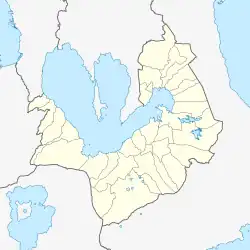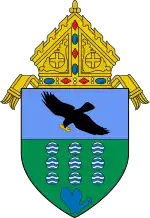Saint John the Baptist Parish Church (Liliw)
St. John the Baptist Parish Church (Filipino: Simbahan ng Parokya ng San Juan Bautista), also known as Liliw Church or Lilio Church, is one of the Roman Catholic churches in Liliw, Laguna, Philippines. Its feast is celebrated every August 29 known as the Martyrdom of St. John the Baptist. The church is known for its red bricked façade and baroque style architecture.
| Liliw Church | |
|---|---|
| St. John the Baptist Parish Church | |
 Facade of Lilio Church | |
 Liliw Church .svg.png.webp) Liliw Church .svg.png.webp) Liliw Church | |
| 14°07′47″N 121°26′09″E | |
| Location | Liliw, Laguna |
| Country | Philippines |
| Denomination | Roman Catholic |
| History | |
| Status | Parish church |
| Founded | 1578 |
| Founder(s) | Venerable Juan de Plasencia |
| Dedication | St. John the Baptist |
| Relics held | A 1st Class Relic of St. Bonaventure stored at Capilla de San Buenaventura |
| Architecture | |
| Functional status | Active |
| Architectural type | Church building |
| Style | Baroque |
| Groundbreaking | 1643 |
| Completed | 1646 |
| Specifications | |
| Materials | Adobe, Clay Bricks |
| Administration | |
| Archdiocese | Manila |
| Diocese | San Pablo |
| Clergy | |
| Vicar(s) | none |
| Priest(s) | Reynaldo Hayag |
History
Liliw was established as a reduccion by Franciscan priests Juan de Plasencia and Diego Oropesa in 1578.[1] It was annexed as a visita of Nagcarlan until it became an independent parish with Miguel de San Lucas as first parish priest in 1605 by the Franciscan missionaries. The first church was built in wood in 1620. A stronger stone church was built from 1643 to 1646 and was partially destroyed during the 1880 Luzon earthquake.[2] It was reconstructed in 1885 and was partially burned on April 6, 1898.[3]
Architecture
The church, which is designed in baroque style, is adorned with red bricks.[4]
Façade
The most prominent and notable part of the church is the façade is made of striking red bricks and adobe.[5] On top of the wooden door entrance is a white sculpted image of the Baptism of Jesus by St. John the Baptist. It also contains stained glass images along with red bricked columns.
Retablos
The church has three retablos or altars finished in gold leaf. The retablo mayor (main altar) at the center contains thirteen niches across four levels housing statues of saints.[6] At the center of the lowest level contains the tabernacle. The two minor retablos on each side houses four niches of saints. Originally, these two minor retablos were dedicated in honor of the town's second patron, San Buenaventura and San Antonio de Padua. The first minor retablo at the left side; St. Joseph at the top, St. Joachim, at the right sided bottom, Immaculate Conception at the middle bottom, and St. Anne at the left sided bottom. Hence, the statue of St. Lorenzo Ruiz at the top of the minor retablo, St. Therese of Lisieux at the left sided bottom, St. Isidore the Laborer at the middle bottom and St. John Marie Vienney at the right sided bottom. It was restored by following the description of a visiting friar through the efforts of Director Emmanuel 'Maning' Borlaza, Mrs. Concepcion Brosas and the people of Liliw.
Capilla de San Buenaventura
From the church's entresuelo entrance, a small passageway to the left leads to a small chapel named in honor of the Seraphic Doctor, San Buenaventura through the efforts of Philip Atienza. At the center of the chapel is an image of San Buenaventura enclosed in a retablo with narra wood in the patio grounds as its material made by a local Paete carver, Peter Paraiso. A first class relic was also housed in the chapel.[5] In 1664, the image of San Buenaventura wept and sweated blood, with Padre Juan Pastor and 120 witnesses.[7] On the right side of the church's entrance is the adoration chapel of the church. It was originally the baptisterio of the church. The original marble baptismal font was intact and kept inside the parish museum.
Church Patio
The grounds outside the church have been developed to promote Christian teachings for pilgrims. At the middle of the patio is a white statue of the Sacred Heart of Jesus. On both sides, several elevated white statues of different saints patron of each barangay in the town. The church patio was named, Patio de Sagrada Familia.[5][6]
Notes
- Huerta 1865, p. 145
- "American Journal of Science - Art.V. The earthquake of the Philippine Islands, July 1880", pp.52–57.
- "Towns and Cities - Liliw". Retrieved June 26, 2014.
- "Tourist Spot in Liliw, Laguna". Archived from the original on June 11, 2014. Retrieved June 26, 2014.
- "The simple pleasures of life in Liliw". philSTAR.com. Retrieved June 26, 2014.
- "St. John the Baptist Church at Liliw". Retrieved June 26, 2014.
- Huerta 1865, p. 146
Bibliography
- Huerta, Felix de (1865). Estado geográfico, topográfico, estadístico, histórico-religioso. Binondo: Imprenta de M. Sanchez y Ca.
External links
![]() Media related to Liliw Church at Wikimedia Commons
Media related to Liliw Church at Wikimedia Commons
- Saint John the Baptist Parish Liliw, Laguna (Official Facebook page)
